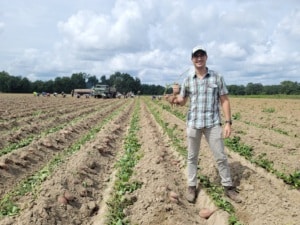Occasionally, I will read an article that a friend, family member or colleague has shared with me about groundbreaking advancements in agriculture, and it usually starts with a title like “All in one planter: till, seed and fertilize in a single pass” or “Autonomous tractors! Let a robot farm for you.” I always think, “Wow, this is really cool!” And then, I notice little interest from farmers to adopt these technologies. Despite being available in the marketplace, many of these innovations do not gain enough traction to become normalized in the industry. Drones provide a good example of this, as farmers have been reluctant to invest in these despite the decades the technology has been available. Over time, I have seen the gap widen between the number of innovations breaking into the market and the number of farmers adopting them. Why is this the case? I believe that we, as scientists and innovators, need to improve our communication strategies to boost the adoption of valuable agricultural technologies.
Over my prior two years as a Ph.D. engineering student studying precision agriculture at North Carolina State University, I have had conversations with farmers of varied backgrounds and come to understand that they are welcoming of precision agriculture innovations. But, from what I gather, there are still financial and other barriers that hinder their investment in such technologies. These include high initial costs, need for technical expertise, limited access to internet in the field and general risk aversion. Additionally, factors like fluctuating commodity prices and weather unpredictability may contribute to the slow adoption process. Given the uncertainty that comes with investing in new innovations, it is understandable that farmers may be hesitant to embrace agricultural innovations. Although innovations are likely to remain costly, farmers have been utilizing expensive tools like automated guidance and variable rate applications, as well as investing in seed technologies like genetically modified plants for some time now. Their primary motivation is to remain competitive in a market that has already embraced these technologies and has witnessed their ability to reduce farming expenses or increase yields. So, motivation exists from an innovator’s perspective to continue developing these technologies. However, I think there needs to be more transparency in the value proposition of new innovations to ensure their success. As a former boss would say, “show me where the money is, and we will take it from there.”
 Enrique Pena Martinez in a sweet potato field
Enrique Pena Martinez in a sweet potato field
I think that we, as university scientist-innovators, must take a step back from solely producing new innovations and redirect our efforts towards helping farmers overcome the challenges that hinder adoption rates. To achieve this, we must view innovation from a farmer’s perspective rather than only seeing it from an innovator’s point of view. It is not enough to just demonstrate the utility of an innovation. We must collaborate with farmers and jointly use the technology as it is developed and after its insertion in the market to boost adoption rates. If, together, we can pilot the innovation through the highs and lows of farming, we are accomplishing three things: instilling confidence in farmers, showing farmers the value of our innovation and learning about those doubts and concerns that farmers have from a farmer’s perspective.
To provide an example, my Ph.D. work is focused on constructing and testing an industrial-scale, high-throughput scanner that uses artificial intelligence to phenotype sweet potatoes in a packing facility. Some of these descriptors may be unfamiliar, but that is exactly my point. While I construct this scanner and demonstrate its use and benefits, I need to clearly explain what it does while providing evidence of my scanner’s value to farmers and other stakeholders. Throughout our collaboration with growers in North Carolina, we have identified major and minor problems with the product, and now the scanner is a step closer to fitting their exact needs. We are both discovering “where the money is” before farmers officially adopt the technology. This also shows accountability and a sense of commitment on the innovator’s side.
We still have a long way to go in terms of leveling adoption rates with the rate of groundbreaking agricultural innovations entering the market. However, we can begin meaningful conversations with our farmers to genuinely comprehend their needs and values. Instead of introducing new products that only cater to a select few, scientists should focus their efforts on addressing adoption-related challenges. Farmers would love to have the latest technologies at their disposal. But we as scientists and innovators must make a better collaborative effort with farmers to foster an environment that allows them to adopt these next generation technologies.
The FFAR Fellows Program has been an incredible experience thus far. My professional and interpersonal skills have drastically improved from the time I joined. I have learned to communicate effectively with stakeholders, have crucial conversations with my peers and superiors, become more emotionally intelligent and improve in many other areas.
 Vertical image of our high-throughput scanner for phenotyping sweet potatoes in a packing facility
Vertical image of our high-throughput scanner for phenotyping sweet potatoes in a packing facility